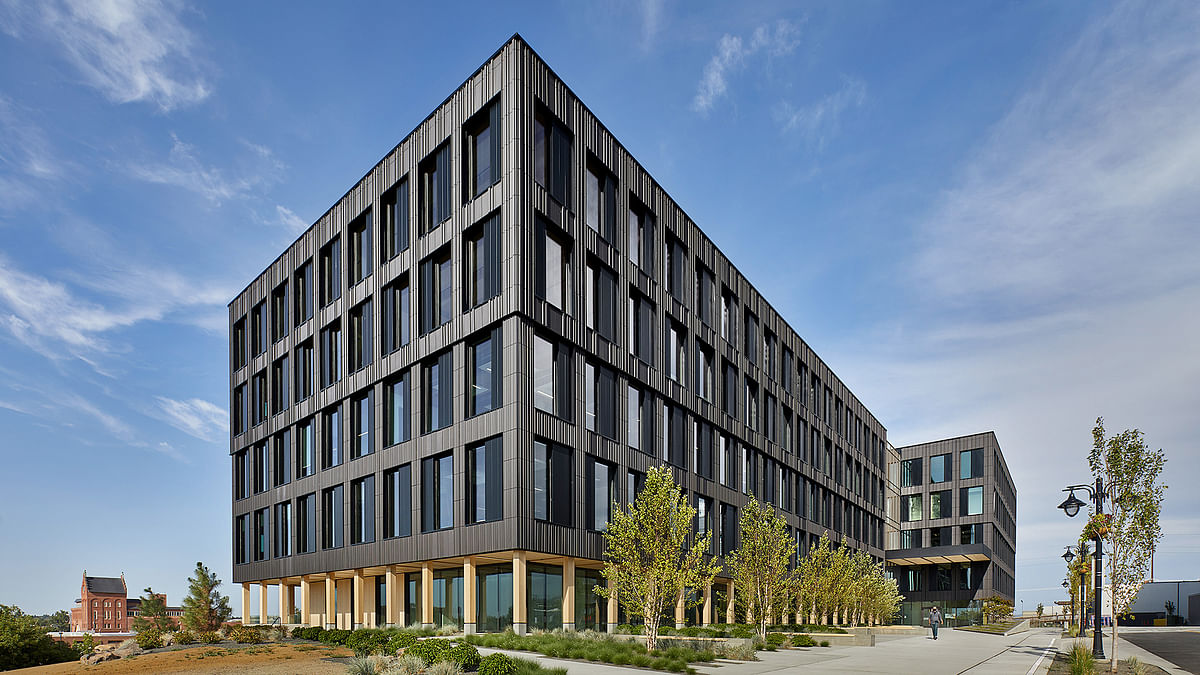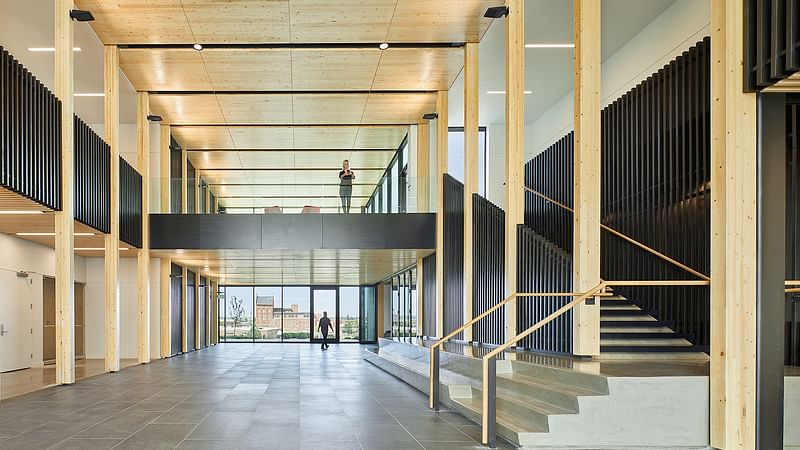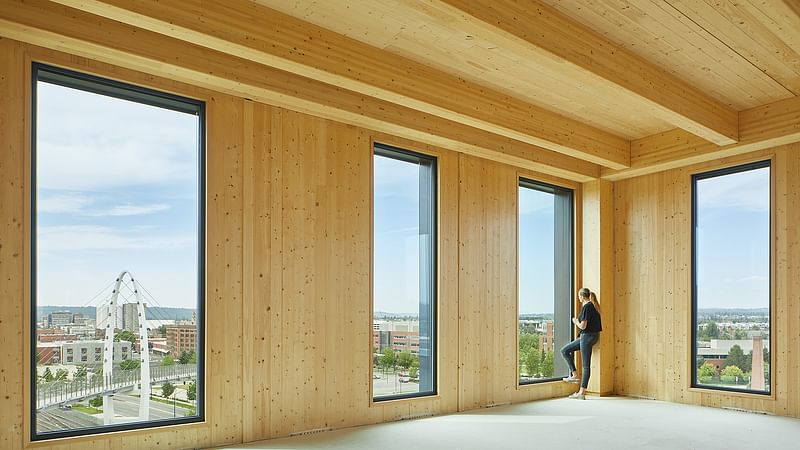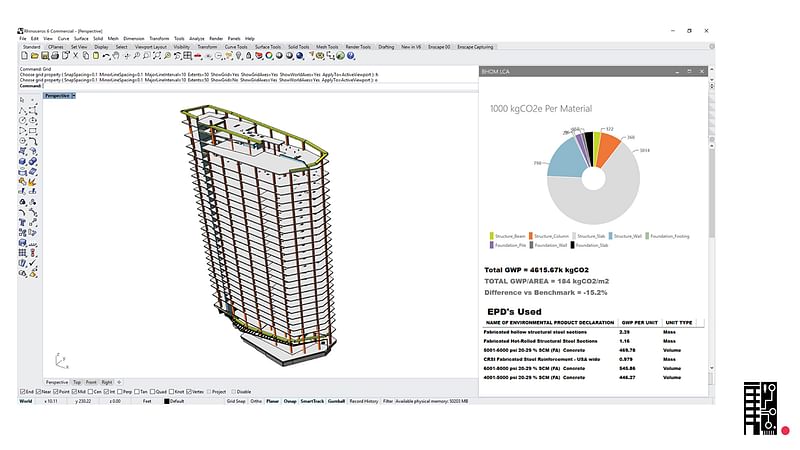AIA Innovation Awards honor cutting-edge green-building solutions
By Alexander Walter|
Tuesday, Mar 9, 2021

Related
Two pioneering projects have been recognized with the AIA's 2020 Innovation Awards: the Catalyst Building in Spokane, Washington, a mass-timber, zero-energy, zero-carbon project designed by Michael Green Architecture and Katerra, won in the Holistic Design category; BHoM Life Cycle Assessment Toolkit, an open-source software tool developed by Buro Happold to measure embodied carbon within building design, triumphed in the Development of Design or Design-Thinking category.
Catalyst Building in Spokane, Washington
Design Architect: MGA | Michael Green Architecture
Architect of Record: Katerra
Project summary: "Born of close collaboration and a set of shared values, Spokane’s Catalyst Building is a testament to the fact that wood buildings can meet and exceed the performance of their steel and concrete counterpoints. Composed of more than 4,000 cubic meters of cross-laminated timber and glulam products, it is expected to be one of the largest buildings in North America to achieve Zero Energy and Zero Carbon certifications from the International Living Future Institute."

"The team employed a number of mass timber solutions where steel, concrete, or framed systems would be traditionally called upon. The resulting 165,000-square-foot, five-story, high-performing building was delivered for less than $250 per square foot. Perhaps more importantly, a life cycle assessment has demonstrated that the timber’s carbon storage almost completely offsets the carbon impact generated by construction. [...] The innovative use of timber in the primary structure, lateral shear walls, and exterior walls required the design and build teams to collaborate closely to develop smart construction and installation solutions, chief among them prefabricated systems. The exterior walls were partially prefabricated off-site to allow for faster dry-in times and to reduce exterior trade coordination. Similarly, the ribbed floor panels and slat walls found in the lobby were also prefabricated in an effort to reduce field labor."

"A number of passive strategies were employed for the building, including rainwater capture, envelope design based on the Passive House Standard principles, and durable material application with a design life expectancy of 75 years. It is also topped with a significant solar photovoltaic array that will generate upward of 300,000 kilowatt-hours per year. Adjacent to the Catalyst Building, the Scott Morris Centre for Energy Innovation houses the centralized heating, cooling, and electrical systems for the Innovation District. This system includes solar panels, battery, and thermal storage, and is managed through a smart grid that allows for real-time, automated energy management, resulting in lower energy consumption and expense." ~ Click here to read more about this project.
BHoM Life Cycle Assessment Toolkit
Architect: Buro Happold
Project summary: "This valuable new tool, an open-source endeavor, is an accessible and
data-driven framework that allows design professionals to measure
embodied carbon of all elements within building design. Supported by a
network of architects, engineers, and software developers who have
contributed code to it, the Buildings and Habitats object Model (BHoM)
boasts an impressive range of functionality that spans multiple
disciplines and represents a transformative and democratic approach to
measuring embodied carbon in everyday construction materials."

"Buro Happold launched BHoM as a data exchange network in 2016, seeking to build a stable framework for the code generated by architects and engineers across the world. Its initial goals were to create a way to share that code across the many platforms designers use every day, resulting in more than 60 adapters for different software and toolkits. Buro Happold released BHoM to the entire profession in 2018 and has continued to refine it further by collaborating with other open-source projects. Since then, the number of code contributors from both inside and outside the firm stands at 87."

"The tool was born out of a mission to quantify the environmental impact of materials in a transparent way with no payment barrier. This mission aligns perfectly with BHoM’s open-source origin, and, with that at its core, it allows users to access BIM data from Rhino or Revit; move that data into Grasshopper, Dynamo, or Excel; and ultimately export the results to visualization engines or databases for closer inspection."

"Free access to the tool allows users to take embodied carbon measurements at any point in the design process, facilitating better material selection. It leverages the significant experience of Buro Happold’s sustainability, structures, and MEP teams to include a full suite of datasets and environmental impact calculation methods. By opening it up to the entire profession, Buro Happold hopes to continue to improve its methods based on the input it receives." ~ Click here to read more about the project.
The award jury included Violet Whitney, Chair, SideWalk Labs, New York, NY; Chris Giattina, BLOX, Bessemer, AL; William Zahner, Hon. AIA, A Zahner Company, Kansas City, MS; Yanel deAngel, AIA, Perkins+Will, Boston, MA; and Charlie Williams, AIA, LPA, Irvine, CA.

RELATED NEWS Edward Mazria named 2021 AIA Gold Medalist, Moody Nolan wins AIA Architecture Firm Award

RELATED NEWS Watch the winning AIA Film Challenge 2020 entries


Share
0 Comments
Comment as :